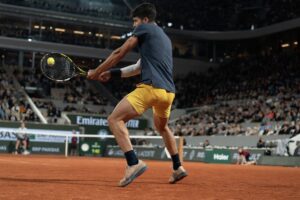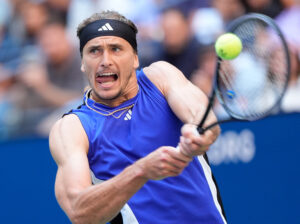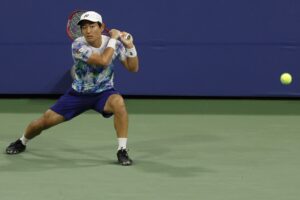Paris in springtime, and specifically at the end of May, is clearly the place to be this year to see some of the greatest stars of tennis. First, Roger Federer announced that he would miss most of the European clay court season to recover physically and mentally after his almost unbelievable efforts so far this year and would only play at the biggest clay court tournament of them all, the French Open. Then this week Petra Kvitova, the two-time Wimbledon champion and multiple Fed Cup winner with the Czech Republic, announced that she has “a chance” of returning to the women’s tour at Roland Garros. If she does play in Paris, her comeback may be even more remarkable than that of the sainted Roger.
Typical ofmost tennis stars these days, Kvitova made her announcement on social media, explaining on Instagram that she had officially added her name to the Paris entry list because the deadline for doing so was approaching and, far more importantly, because her recovery from injury had been going so well that she had genuine hope of appearing in the French capital.
“There remains a long road ahead”
Petra Kvitova
“I want to give myself every last opportunity to be able to compete at one of my favourite events”, she wrote, before adding, “This unfortunately does not mean necessarily that I will be ready to play in Paris, but that I’m doing everything possible to give myself the chance and keep a positive mindset. There remains a long road ahead but I wanted to share this update with you.”
Of course, Kvitova’s injury is no normal tennis injury; in fact, it is extremely abnormal, with only Monica Seles suffering something similar during her career. She was seriously injured last December when she interrupted an intruder at her home in Prostejov in the Czech Republic, only a few weeks after participating in her country’s latest triumph in the Fed Cup. Her left hand—the hand she holds the racket with—was badly cut when the intruder used a knife to fight her off, and she suffered considerable damage to the tendons and nerves.
According to Kvitova, she is making a good physical recovery, but of course the real demons that she must confront are mental ones. She has never been one of the most “solid” women’s players, instead relying on the periodic streaks of apparent invincibility that swept her to her two Wimbledon titles in 2011 and 2014. Consequently, she may find it more difficult to return to the tour than players who are mentally stronger than her.
Similarities with Seles
The obvious point of comparison with Kvitova’s situation is with that of Monica Seles more than two decades ago. In 1993, Seles was stabbed on court in Hamburg by a fanatical Steffi Graf admirer, who wanted to stop Steffi’s great rival at the time from overtaking her as the dominant female player of her generation. Seles was undoubtedly more mentally “solid” than Kvitova (she was one of the toughest and most consistent women players ever), but her attack took place on court and in the full glare of the world’s media. As a result, it took her more than two years to recover sufficiently to reappear on tour and she was undoubtedly never the same player again, winning only one more Grand Slam title after her attack (the 1996 Australian Open), having won eight Majors beforehand.
Obviously, there are significant differences between the attacks on Seles and Kvitova. Most importantly, Kvitova was not attacked deliberately and the incident took place in her own home. Although that might make her more anxious about her domestic security, it also means that, unlike Seles, she will not have to overcome any problems specifically related to returning to the court and appearing again in public.
Petra Kvitova absence just one cog in a chaotic WTA
Of course, the uncertainty surrounding Kvitova is symptomatic of the general uncertainty surrounding the women’s game at the moment. Serena Williams announced her pregnancy this week (selecting Snapchat rather than Instagram to break her big news), which will mean she misses at least the remaining three Grand Slam tournaments this year. Angelique Kerber is struggling to justify her World No.1 status, as she oscillates between brilliance and banality. There are other sub-plots, such as the return of Victoria Azarenka after she gave birth last year. Consequently, there is undeniably an air of doubt and intrigue about the top of the women’s game.
However, sport abhors a vacuum even more than nature, and the current difficulties that many of the top women players are experiencing means that there is a great opportunity for other players to step in and seize the game’s top prizes, beginning at Roland Garros. If Maria Sharapova is granted a wild card entry in Paris after her long and enforced lay-off from the game, she may start as one of the favourites, having twice won on the fabled red dirt. Equally, the 2017 French Open may be the perfect opportunity for Garbiñe Muguruza to remind herself and the rest of the world that she is the defending champion, despite having done relatively little since winning her maiden Grand Slam at Roland Garros last year. And for a real outlier, if she can still be considered as such given her huge progress over the last 18 months, Britain’s Johanna Konta might just be able to use her new-found mental strength to fight her way to the final.
Is Petra Kvitova a French Open contender?
It is in this context that the possible comeback of Petra Kvitova is so tantalizing. At her absolute best, as she was at Wimbledon in 2011 and again three years later, she has the combination of sheer power and outrageous shot-making ability to trouble any of the other potential contenders in Paris. It is obviously asking an enormous amount of the tall and talented Czech to compete for a Grand Slam so soon into her comeback; it will be enough of an achievement for her just to make the main draw at Roland Garros. In addition, for all that she describes the French Open as one of her “favourite events,” her record there is not great, as she has only ever reached one semifinal, in 2012, and even then was beaten in straight sets by Sharapova (who gained a modicum of revenge for losing to Kvitova in the 2011 Wimbledon final).
The fact is that Kvitova is not really a clay-court player at all. With her powerful serve and strong ground-strokes, it is grass that really suits her game, just as it ideally suited that of her fellow Czech left-hander, Martina Navratilova. Indeed, when Kvitova first won Wimbledon in 2011, she was almost endlessly compared to Navratilova and some tennis observers predicted that she might go on to emulate Navratilova’s success in SW19. Of course, that has proved not to be the case, not least because Kvitova seems to lack the mental toughness and sheer will to win of Navratilova.
Nevertheless, if Kvitova can take her first and probably faltering steps on the comeback trail in Paris, the experience will no doubt stand her in good stead for Wimbledon, where, if she has made a complete physical and mental recovery from her injuries, she will have a chance of establishing her own unique record. Navratilova may have won a total of nine Wimbledon singles titles, but if Kvitova can somehow win this year (and at this stage that is obviously an enormous “ask”), she will have won Wimbledon three times in total, with a three-year gap between both her second and third titles. That may not be enough to match Martina’s domination on grass, but after Kvitova’s horrific end to 2016 it will still be a remarkable achievement.
Main Photo:






